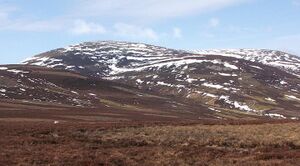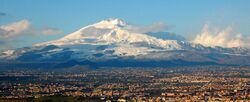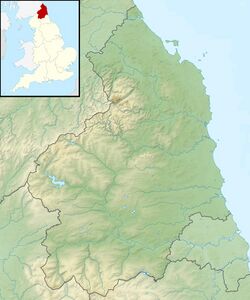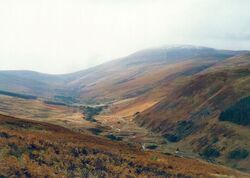Earth:The Cheviot
| The Cheviot | |
|---|---|
 The Cheviot in snow | |
| Highest point | |
| Elevation | 815 m (2,674 ft) [1][2] |
| Prominence | 556 m (1,824 ft) [2] |
| Parent peak | Broad Law |
| Listing | Marilyn, Hewitt, County Top, Nuttall |
| Coordinates | [ ⚑ ] : 55°28′42″N 2°08′44″W / 55.47823°N 2.14553°W |
| Naming | |
| English translation | (Hill) having the quality of a ridge |
| Language of name | Common Brittonic[3] |
| Geography | |
| Location | Cheviot Hills, England |
| OS grid | NT909205 |
| Topo map | OS Landranger 74/75 |
| Geology | |
| Age of rock | Early Devonian[4] |
| Mountain type | Stratovolcano (extinct) |
| Last eruption | +393 MYA[4] |
The Cheviot (/ˈtʃiːviət/) is an extinct volcano and the highest summit in the Cheviot Hills and in the county of Northumberland.[1][5] Located in the extreme north of England , it is a 1 1⁄4-mile (2-kilometre) walk from the Scottish border and, with a height of 2,674 feet (815 metres) above sea-level, is located on the northernmost few miles of the Pennine Way,[6] before the descent into Kirk Yetholm.
The Cheviot was formed when melting in the crust over 390 million years ago gave rise to volcanic activity, and it has subsequently sustained intense erosion.[7] Several watercourses radiate from The Cheviot.[8]
Etymology
The name Cheviot, which was first documented in 1181 as Chiuiet,[9] is probably of Brittonic origin.[3] The name involves the element *ceμ-, meaning "a ridge", and the nominal suffix -ed, which in place-names can mean "having the quality of".[3]
Geography
At 2,674 feet (815 metres) above sea-level, The Cheviot is the highest point in the Cheviot Hills, the county top of Northumberland, England's highest point outside of Cumbria and fourth-highest outside the Lake District, after Cross Fell, Great Dun Fell and Little Dun Fell.[10][11] It is located in the Northumberland National Park and is 41 miles (66 kilometres) from the city of Newcastle-upon-Tyne.[12] It can be viewed in the distance from the peak of Cow Hill on the Town Moor, the city's largest park.[13] The summit is a triangular plateau covered with peat quagmires.[14]
Usway Burn, a tributary of the Coquet, rises on The Cheviot, as do College Burn, which merges with the Bowmont Water to form the River Glen near Kirk Newton, and Harthope Burn.[15][16][6]
Geology

The Cheviot is an extinct stratovolcano eruptive during the Caledonian orogeny (490-390 Ma), in which volcanic activity arose from melting within the mantle crust.[18][7] The mountain is heavily eroded, and originally may have been as high as 10,000 ft (3,000 m), with a diameter perhaps of 37 miles (60 km).[18][19] Volcanic vents may have been located along the faults at Harthope and Thirl Moor.[20] The earliest volcanic activity in the area was violent and explosive, with exposed ash and ignimbrite showing pyroclastic flows to have reached Coquetdale and Ingram.[20] Later activity consisted of andesitic, trachyte and rhyolitic lava extrusion, which abnormally for such lavas, covered an area as large as 230 sq mi (600 km2).[20] Lavas erupted from the Cheviot underlie Branxton and Flodden Ridge.[18]
Granitic magma was intruded into the layers of lava during the time period immediately before the volcano became inactive. The resulting 19 sq mi (50 km2) pluton was exposed by erosion during the Carboniferous (+298 Ma).[20]
Glacial till in common in the area, which is a remnant of the Last Ice Age (< 115 Ka), during which the Cheviots were beneath ice sheets.[4] The peat expanses date from the immediately post-glacial period.[4]
Human history
Flattened remnants of a Neolithic henge monument have been uncovered at nearby Hethpool.[21] The stone circle may date to around 2500 BC, and is hypothesized to have been a ritualistic gateway to the mountain.[21]
Harthope Burn, which cuts a deep valley on the flanks of The Cheviot, marked the boundary between the reivers of the English East and Middle Marches in the 16th and 17th century.[22]
During World War II, The Cheviot and the hills surrounding it were the site of aircraft crashes which claimed the lives both of Allied and German airmen.[21] A local shepherd John Dagg and his sheepdog rescued a pilot following an Royal Air Force crash in 1942.[23] Dagg also rescued survivors of a crash in December 1944, which killed 2 members of a 9-man US Air Force crew.[23] Aircraft wreckage is still seen on the mountain today.
Access
Other than the route via the Pennine Way, most routes up the Cheviot start from the Harthope Burn side to the northeast, which provides the nearest access by road. The summit is around 3 mi (5 km) from the road-end at Langleeford; across the valley to the east is the rounded peak of Hedgehope. There are routes following the ridges above either side of the valley, and a route that sticks to the valley floor until it climbs to the summit of the Cheviot from the head of the valley.
Although the Pennine Way does a 2 mi (3 km) out-and-back detour to the Cheviot, many walkers who come this way omit it, since the stage (the most northerly) is 29 mi (47 km) long.
View
The view is obscured greatly by the flatness of the summit plateau. Nevertheless, on a clear day the following are visible (from west, clockwise); Broad Law, Moorfoot Hills, Pentland Hills, the Ochils, Lammermuir Hills, Ros Hill, Long Crag, Urra Moor, Tosson Hill, Burnhope Seat, Cross Fell, Helvellyn, Scafell Pike, Skiddaw, Sighty Crag, Peel Fell, and Queensberry. The longest possible line of sight from the Cheviot is to Beinn a' Ghlò, 112 miles away in the Grampians of the Scottish Highlands.[12]
Subsidiary SMC summits
| Summit | Height (m) | Listing |
|---|---|---|
| Cairn Hill West Top [Hangingstone Hill] | 743 | DT,CoH,Bg,xN[24] |
References
- ↑ 1.0 1.1 Bathurst, David (2012). Walking the county high points of England. Chichester: Summersdale. pp. 264–271. ISBN 978-1-84-953239-6.
- ↑ 2.0 2.1 "The Cheviot". http://www.hill-bagging.co.uk/mountaindetails.php?qu=&rf=2302.
- ↑ 3.0 3.1 3.2 James, Alan. "A Guide to the Place-Name Evidence". http://spns.org.uk/wp-content/uploads/2017/04/Alan_James_Brittonic_Language_in_the_Old_North_BLITON_Volume_II_Dictionary.pdf.
- ↑ 4.0 4.1 4.2 4.3 Scrutton, Colin. "Page 1 Cheviot - early Devonian volcanic rocks, granite and basement". http://webcache.googleusercontent.com/search?q=cache:q2yauNr7caEJ:earthwise.bgs.ac.uk/index.php%3Ftitle%3DCheviot_%25E2%2580%2594_early_Devonian_volcanic_rocks,_granite_and_basement_-_an_excursion%26action%3Dmpdf+&cd=2&hl=en&ct=clnk&gl=uk.
- ↑ Hall, Gemma (2012). Slow Northumberland and Durham. Slow Northumberland and Durham - Including Newcastle, Hadrian's Wall and the Coast: Bradt Travel Guides. ISBN 9781841624334.
- ↑ 6.0 6.1 "The Cheviot". https://www.northumberlandnationalpark.org.uk/.
- ↑ 7.0 7.1 Geological history of Northumbria. Yorkshire Geological Society. Retrieved November 28, 2021.
- ↑ [1] How this tranquil part of the North East is far from the madding crowd . Chronicle Live. Retrieved November 28, 2021.
- ↑ Mawer, Allen (1920). The Place-Names of Northumberland and Durham. University Press. p. 44. https://archive.org/stream/cu31924028042996/cu31924028042996_djvu.txt. Retrieved 22 March 2021.
- ↑ Jones, Paul Anthony (7 November 2012). The British Isles - A Traveler Gazetteer. Summerdale Publishers LTD. ISBN 9780857658159. https://books.google.com/books?id=A0j0CQAAQBAJ. Retrieved 22 September 2022.
- ↑ Banks, Francis Richard (1977). The Borders. Batsford. ISBN 9780713402896. https://books.google.com/books?id=2CIjAAAAMAAJ. Retrieved 22 September 2022.
- ↑ 12.0 12.1 "Cheviot - Panoramas". http://www.viewfinderpanoramas.org/panoramas/ENG/CHEVIOT.GIF.
- ↑ [2]
- ↑ Pevsner, Nikolaus; Richmond, Ian Archibald; Grundy, John; Ryder, Peter; McCombie, Grace; Welfare, Humphrey (11 March 1992). Northumberland. Yale University Press. ISBN 9780300096385.
- ↑ New Sporting Magazine - Volume 9. 1835. https://books.google.com/books?id=5oUEAAAAQAAJ.
- ↑ Haselhurst, S Rennie (1913). Northumberland. Cambridge University Press. ISBN 9781107677500. https://books.google.com/books?id=FLRvFIqbhFgC. Retrieved 10 June 2021.
- ↑ "Walking in a volcano.". https://www.northumberlandnationalpark.org.uk/events/walking-in-a-volcano/event-3669/.
- ↑ 18.0 18.1 18.2 Kille, Ian. "15. Geology of the battlefield and wider landscape". https://www.flodden1513ecomuseum.org/project/flodden-an-ancient-landscape/15-geology-of-the-battlefield-and-wider-landscape.
- ↑ Upton, B. G. J. (2015). Volcanoes and the Making of Scotland. Dunedin Academic Press Ltd. ISBN 978-1780465418. https://books.google.com/books?id=fVxwDwAAQBAJ. Retrieved 14 August 2019.
- ↑ 20.0 20.1 20.2 20.3 "The Cheviot Hills". https://www.geologynorth.uk/the-cheviot-hills/.
- ↑ 21.0 21.1 21.2 "Historical Sites". https://www.college-valley.co.uk/about-us/historical-sites/.
- ↑ Earle (Northumberland). 4 November 2016. http://www.keystothepast.info/article/10339/Site-Details?PRN=N13768.
- ↑ 23.0 23.1 Daniel, Brian (19 December 2014). "Aircrew remembered at ceremony 70 years on from crash in the Northumberland Cheviot Hills". https://www.chroniclelive.co.uk/news/north-east-news/aircrew-remembered-ceremony-70-years-8318086.
- ↑ "Cairn Hill West Top [Hangingstone Hill]". http://www.hill-bagging.co.uk/mountaindetails.php?rf=1846.
External links
- Computer generated summit panorama The Cheviot
 |





